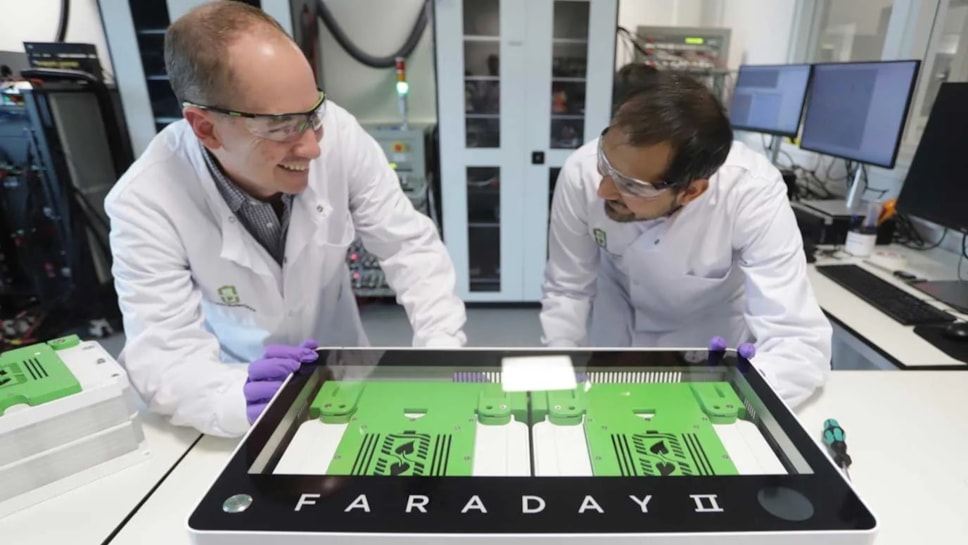
Unlocking affordable energy: the role of battery storage in a dynamic energy system
“Sustainable, affordable, and for everyone.” We’re supporting the development of a revolutionary polymer-based battery – a safe, sustainable, and cost-effective energy storage option for a wide range of consumers
“The transition to new energy means making it simple and valuable for all consumers – whether that is generating, using, returning or, just as importantly, storing. Storage is a key part of making energy sustainable, affordable, and for everyone.”
E.ON Next’s Head of Partnerships, Andy Sage, speaking at the launch of Cambridge-based energy storage technology company Superdielectrics’ next generation battery, Faraday 2, on the role batteries and energy storage will play in the future energy system.
Earlier this year, E.ON and Superdielectrics announced a wide-ranging collaboration focused on accelerating the development and deployment of the Faraday system, with the next step being the creation of larger prototypes that can be trialled in customers’ homes. This collaboration ultimately aims to give millions of homes access to safer, cleaner, and more affordable energy.
As we move towards a greener and more sustainable energy future, flexibility and battery storage will play an increasingly important role in making energy affordable for everyone. By embracing these technologies, we can create a more resilient and cost-effective energy system that benefits both consumers and the environment.
“For energy consumers, it's about participation in a flexible energy system,” Andy said at the launch event in London. ”For example, those homes that can't have solar panels or can't have a heat pump, or they can't plug an electric car into their home . . . they can still participate because they can store. It should just be a simple case of, ‘yeah, my energy's still there when I want it, when I need it, and it's a value that I enjoy’.”
Flexibility: the key to a resilient energy system
Flexibility in the energy system is the ability to adapt to changes in energy demand and supply – either when demand goes up or in those times when wind and solar generation are affected by the weather.
This adaptability is crucial in making best use of renewable energy sources like wind and solar. By integrating flexible solutions, such as demand response programmes and smart grid technologies, energy providers can better match supply with demand, reducing the need for expensive and often fossil fuelled power plants to add power into the grid.
For consumers, this means lower energy costs. When energy demand can be shifted to times when renewable energy is abundant and cheaper, customers can benefit from reduced prices. At the same time, flexibility helps in preventing blackouts and ensuring a reliable energy supply, which is essential for both residential and commercial users.
For consumers, the integration of such technologies translates to real savings on energy bills.
E.ON Next’s Smart-Saver tariff is a great example – it has set times of the day when energy is cheaper. Having a simple low-cost battery in homes means taking advantage of the cheaper electricity and using it later during the more expensive peak times – or even returning it for money off the bill.
Exploring that challenge is what we are doing with Superdielectrics. With 47 million customers across Europe we have a lot of connections with people and their energy, a lot of vision into how things work and how storage operates in the different environments and with different customers behaviours.
As Andy says: “With any technology, with any battery or any storage design, one of the important parts is knowing behaviour, the use of the battery. It's really pleasing to just be a part of that to provide the data, the insights.
“We've got access to a huge amount of information. and this tells us how different storage systems are used. How energy is used, how that changes when storage is introduced. If energy's going to be more expensive at certain times of the day, how do you effectively avoid those expensive times?”
Ultimately, technologies like Faraday 2 are a step towards a cleaner and fairer energy future. With its reliance on polymers (similar to contact lens materials) rather than rare metals and other mined materials, the aim is to create a lower cost, more affordable technology for the largest group of consumers, creating a much more accessible way to participate in a flexible energy system.
With relationships like this we are helping the right companies the right times to achieve that aim of sustainable energy.

